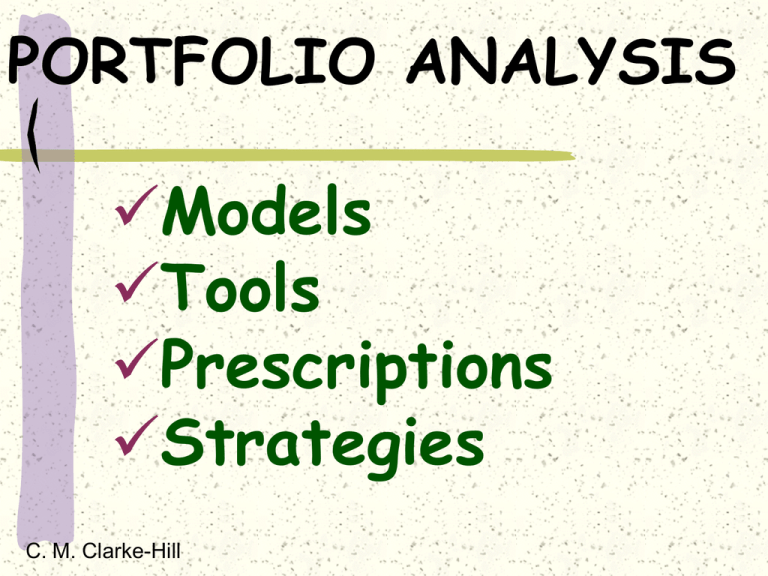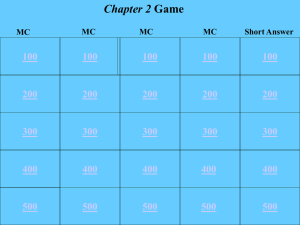portfolio - Management Class
advertisement

PORTFOLIO ANALYSIS Models Tools Prescriptions Strategies C. M. Clarke-Hill BUILDING SHAREHOLDER VALUE How attractive is group of businesses firm is in? How good is overall performance outlook over next five years? If previous answers are not satisfactory, what should firm do to: - Get out of some businesses - Strengthen position of remaining ones - Acquire new businesses to boost prospects for better performance PORTFOLIO MODELS A multidivisional firm has the problem of how to allocate resources and to back winners in their ‘portfolio’. Certain Portfolio models are linked with: The Product Life Cycle concept The Experience Curve Concept The PIMS Study PORTFOLIO ANALYSIS Portfolio Models can be used to provide strategic insights by: — Acting as a diagnostic aid — Providing a conceptual framework — Being a prescriptive guide — Being a planning tool PORTFOLIO ANALYSIS THE BOSTON CONSULTANCY GROUP MATRIX THE BCG MATRIX The BCG Matrix is called the Growth Share Matrix because the model combines market growth and relative market share BCG GROWTH SHARE MATRIX HIGH M A R K E T G R O W T H STAR QUESTION MARK ? CASH COW DOG LOW HIGH RELATIVE MARKET SHARE LOW TWO VARIABLES USED Market Growth Rate (Vertical) Relative Market Share (Horizontal) MARKET GROWTH RATE “High Growth” businesses are in markets growing faster than economy “Low growth” businesses are in markets growing slower than economy RELATIVE MARKET SHARE Calculated by dividing firm’s market share by market share of firms largest rival Typical dividing line between “high” and “low” relative market share businesses placed at about .75 or .8 Businesses on left are share leaders Businesses on right are in below-average relative market share positions Each business is a “circle” with size scaled to portion of total corporate revenues generated ASSUMPTIONS UNDER WHICH THE MATRIX IS BASED Cash Generated is proportional to Relative Market Share Cash is needed to keep pace with market growth rate Additional cash is needed to increase market share Growth rate eventually slows to allow cash to be generated BCG STRATEGY PRESCRIPTIONS Within the portfolio context there are FOUR basic strategies that can be pursued: BUILD - a strategy of building market share HOLD - a strategy of holding share relative to competitors and to market growth rate HARVEST - a cash out strategy with little or no new investment QUIT - a strategy of exit or withdrawal BCG GROWTH SHARE MATRIX HIGH M A R K E T G R O W T H LOW STAR QUESTION MARK Strategies: Build CASH COW Strategies: Hold/Harvest HIGH C. M. Clarke-Hill Strategies: Build/Harvest Quit DOG Strategies: Harvest/Quit Build (?) RELATIVE MARKET SHARE LOW PLC AND AN EXTENDED FORM OF GROWTH-SHARE MATRIX Life Cycle Stage Extended Growth Share Types Introduction Stage Infants - negative cash flow Growth Stage Stars Question Marks Maturity Cash Cows Dogs Decline War Horses Dodos M A R K E T G R O W T H BCG CASH FLOW POSITION CHART HIGH STAR Modest positive or negative cash flow CASH COW Large positive cash flow QUESTION MARK Large negative cash flow Optimum Cash Flow DOG Modest positive or negative cash flow LOW HIGH RELATIVE MARKET SHARE LOW BCG PRODUCT DYNAMICS PORTFOLIO CHART HIGH M A R K E T G R O W T H STAR QUESTION MARK Success Sequence Disaster Sequence CASH COW DOG LOW HIGH RELATIVE MARKET SHARE LOW USING THE MATRIX Check for internal balance Look for trends Evaluate the competition Consider factors not captured by the display Develop possible target portfolios Check for financial balance PORTFOLIO BALANCE ? The balanced portfolio is regarded as desirable - can we have other ‘unbalanced’ portfolios? Too Too Too Too many many many many stars? cash cows? question marks? dogs? TOO MANY STARS - (HIGH GROWTH ORIENTED COMPANIES) Problems of cash flow High marketing investments in high growth markets are a pre-requisite to build or hold market share NPD costs need to be funded & capitalised Problems of high growth can be problematical - need for high borrowings TOO MANY QUESTION MARKS Negative cash flows can be problematic for development - can be undercapitalised Question marks can become cash traps High development costs must be capped Question marks are costly in management time Can question marks be ‘turned around’? TOO MANY CASH COWS (PROFIT ORIENTATED COMPANY) Excessive cash inflows Where is the future growth to come from ? High profitability can be used to fund dividends How do you plan for fading cash cows ? TOO MANY DOGS A COMPANY IN DECLINE No growth Modest cash flows Where is the future to be But DOGS can be profitable in the short run Slow or fast decline in the business fortune BCG BALANCED GROWTH SHARE MATRIX HIGH M A R K E T G R O W T H STAR QUESTION MARK 10 2 5 3 6 CASH COW DOG 4 1 9 8 7 LOW HIGH RELATIVE MARKET SHARE LOW WEAKNESSES OF GROWTH- SHARE MATRIX Four-cell matrix hides fact that many businesses are in “average” growth rate markets and have “average” relative market share positions Misleading simplification to categorise businesses into just four types Matrix doesn’t identify which businesses offer best investment opportunities Being a leader in a slow growth market doesn’t guarantee cash cow status. WEAKNESSES OF GROWTH- SHARE MATRIX Assessment of relative long-term attractiveness of business units requires more than just market growth and relative market share Connection between relative market share and profitability is not as tight as experience curve effect implies. Many firms with small relative market shares are profitable. DIRECTIONAL POLICY MATRIX This model is an alternativeto the BCG Matrix, and is based on different criteria. Market attractiveness Business strengths DPM Cont. The two factors of Market Attractiveness and Business Strengths are COMPOSITE measures of potential opportunities open to the firm and the opportunities that the firm can take by leveraging its internal business strengths or competencies. GENERAL ELECTRIC’S MARKET ATTRACTIVENESS - BUSINESS STRENGTH MATRIX Strong High Medium Low Average Weak MARKET ATTRACTIVENESS Market Size Growth Rate Profit Margin Competition Intensity Seasonality Cyclicality Social Impact Regulation Environment Opportunities & Threats Barriers to Exit/Entry Technology & Capital BUSINESS STRENGTH Market Share Core Competencies Profit Margin vs Competitors Ability to Match Price/Service Relative Costs Knowledge Technological Ability Management Caliber CONSTRUCTING ATTRACTIVENESS/ BUSINESS STRENGTH MATRIX Quantitative measures of market attractiveness and business strength used to plot each business unit’s position in the matrix Each business unit appears as a circle. Area of the circle is proportional to size of market. Pie slices within circle reflect business’s market share. RATING INDUSTRY ATTRACTIVENESS Select factors to compare long term attractiveness of each market Assign weights to each attractiveness factor Rate each market on each attractiveness factor, using scale of 1 to 10 Calculate weighted ratings; sum to get to get an overall market attractiveness rating for each market RATING BUSINESS POSITION/COMPETITIVE STRENGTH Select factors to compare competitive strength of each business unit Assign weight to each competitive strength factor Rate each business on each factor using scale of 1 to 10 Calculate weighted ratings; sum to get an overall business unit strength rating for each business. STRATEGY IMPLICATIONS OF ATTRACTIVENESS/STRENGTH MATRIX Businesses in three cells at upper left have top investment priority. General strategic prescription is “grow and build” Business in three diagonal cells given medium investment priority Businesses in lower right of matrix are strong candidates for harvesting or divestment. May be candidates for “overhaul and reposition strategy”. GENERAL ELECTRIC’S MARKET ATTRACTIVENESS - BUSINESS STRENGTH MATRIX Strong High Medium Average Weak Grow and Build Medium Harvest/Divest Low Overhaul and Reposition ADVANTAGES OF ATTRACTIVENESS/STRENGTH MATRIX Allows for intermediate rankings between high & low and strong & weak Incorporates wider variety of strategically relevant variables Stresses channelling of corporate resources to businesses with greatest potential for competitive advantage and superior performance. WEAKNESSES OF ATTRACTIVENESS/STRENGTH MATRIX No real guidance on specifics of business strategy Most to be concluded is general strategic posture Leaves issues of strategic coordination across businesses wide open, as well as issue of specific competitive approaches and action to take at business unit level Tends to obscure businesses about to emerge as winners. PORTFOLIO MODELS IN USE Care when using such models Models help - but - remember the assumptions Different models can offer differing solutions Use your judgement Think of the ‘other’ factors DIFFERENT MODELS DIFFERENT RESULTS Results of a study by Wind, Mahajan and Swire (1983) concluded that when using standardised portfolio models the classification of any business into a specific portfolio position depends on four factors WIND, MAHAJAN AND SWIRE CONT. The operational definition of the dimension used The rule used to divide a dimension in high or low categories The weighting of the variables used in constituting the composite dimensions The specific portfolio model used WIND et al, Cont The issue here is that different models can offer different strategic solutions as SBUs can be classified in different positions There may be unintended benefits different portfolio models give different positions can cause a debate in the strategic process Cash Cow or Dog?









